- CDC
- Heart Failure
- Cardiovascular Clinical Consult
- Adult Immunization
- Hepatic Disease
- Rare Disorders
- Pediatric Immunization
- Implementing The Topcon Ocular Telehealth Platform
- Weight Management
- Monkeypox
- Guidelines
- Men's Health
- Psychiatry
- Allergy
- Nutrition
- Women's Health
- Cardiology
- Substance Use
- Pediatrics
- Kidney Disease
- Genetics
- Complimentary & Alternative Medicine
- Dermatology
- Endocrinology
- Oral Medicine
- Otorhinolaryngologic Diseases
- Pain
- Gastrointestinal Disorders
- Geriatrics
- Infection
- Musculoskeletal Disorders
- Obesity
- Rheumatology
- Technology
- Cancer
- Nephrology
- Anemia
- Neurology
- Pulmonology
Can You Identify These Lumps, Bumps, and Swellings?
A 72-year-old woman came to the emergency department with a tender, swollen left leg.
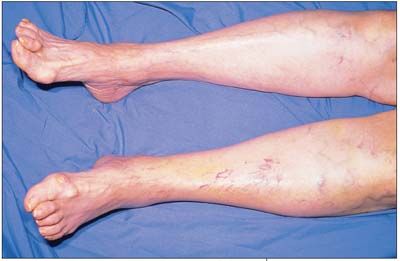
Case 1:
A 72-year-old woman came to the emergency department with a tender, swollen left leg. Pitting and a positive Homans sign were noted, and a presumptive diagnosis of deep venous thrombosis (DVT) was initially made.
The patient was hospitalized, and additional history was obtained. The woman had arthritis but no other factors that might precipitate DVT. The patient also told her physician that the problem started “right at 3 o’clock.” Such an acute onset is unusual in DVT.
What else might have caused the symptoms?
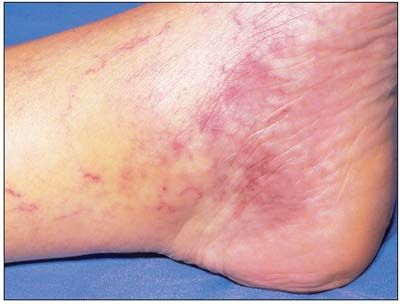
Answer on Next Page

Case 1: Ruptured synovial cyst
This patient, who had a history of arthritis, reported that she had previously had a small lump behind her knee. Given the factors in the history that cast doubt on the diagnosis of DVT, a tentative diagnosis of ruptured synovial cyst was made. (This diagnosis can be confirmed by ultrasonography.)
Note the small area of ecchymosis on the woman’s heel; this finding suggests that blood had tracked down her leg.
Physical findings, and even venous Doppler studies, may not discriminate between DVT and ruptured synovial cyst. However, the distinction is crucial; if heparin is given for a mistaken diagnosis of DVT, marked bleeding within the muscles may ensue.
(Case and photographs courtesy of Dr William F. Keenan.)
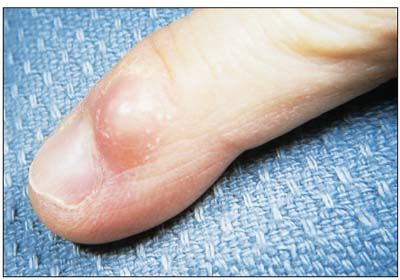
Case 2:
To what do you attribute this painless swelling that recently appeared on a 56-year-old woman's finger?
Answer on Next Page

Case 2: Mucous cyst
This is a digital mucous cyst. It contains clear, viscous, jelly-like mucus and most commonly occurs in middleaged to elderly women.
There are 2 types of digital cysts. The one pictured here occurs proximal to the nail fold, is not connected to the joint space or the tendon sheath, and results from local fibroblast proliferation. The second type occurs on the dorsolateral aspect of the finger at the distal interphalangeal joint; it is actually a herniation of the tendon sheath or the joint lining and is similar to a ganglion. Complete excision of the cyst, together with its pedicle, is required to minimize recurrence.
(Case and photograph courtesy of Dr Robert P. Blereau.)
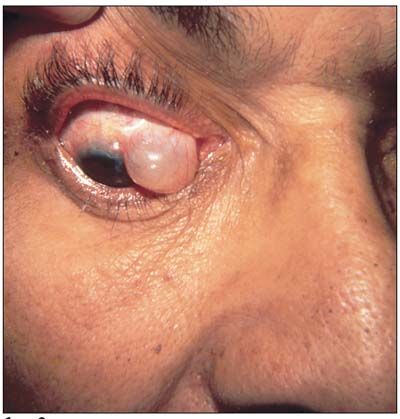
Case 3:
Can you identify this ocular lesion?
Answer on Next Page

Case 3: Conjunctival cyst
The lesion is a conjunctival cyst with an advancing dellen. Treatment was by simple excision.
(Case and photograph courtesy of Dr Barry Katzman.)
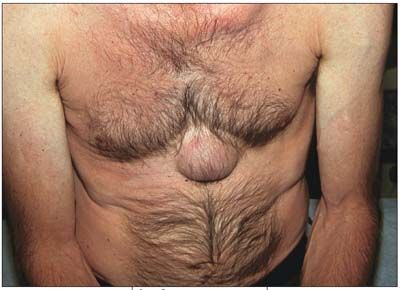
Case 4:
A healthy 57-year-old man presented with a lump in the center of his chest. He said that a small “welt” over his sternum had enlarged rapidly over 2 weeks to its present size, 6 × 8 cm. The mass was firm, rubbery, nontender, and mobile. Needle aspiration revealed only minimal, nonbloody fluid.
What type of growth is this?
Answer on Next Page

Case 4: Sebaceous cyst
When surgically excised, this lesion was found to contain a large amount of caseous, foul-smelling material. Pathological evaluation proved it to be a sebaceous cyst.
(Case and photograph courtesy of Dr Steven Eisenstein.)
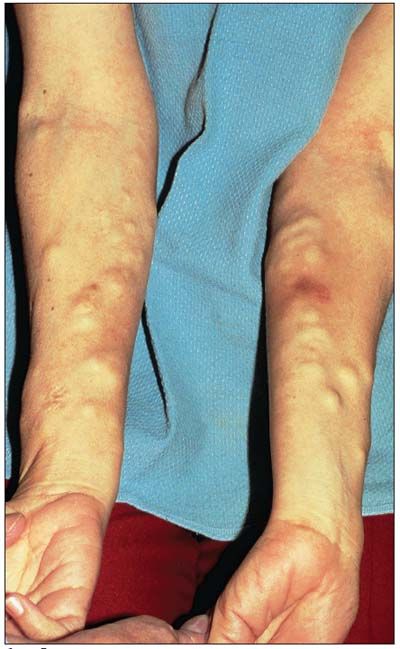
Case 5:
Are these soft, freely movable subcutaneous lesions on the arms of a 38-year-old woman simple sebaceous cysts?
Answer on Next Page

Case 5: Epithelial cysts
These are not sebaceous cysts- there are far too many of them. A biopsy revealed them to be epithelial cysts characteristic of the autosomal dominant disorder steatomatosis, or steatocystoma multiplex. The cysts typically contain lipid and keratin and often result from blockage of follicular orifices.
Although steatomatosis tends to be familial, this patient was the only member of her family with the disorder.
(Case and photograph courtesy of Dr William F. Keenan.)
